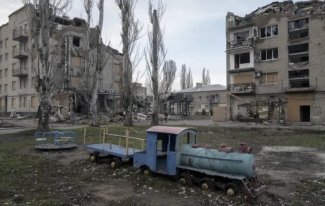Russian soldiers in the centre of Pokrovsk. Day 1343 of the war

![]()
Ukrainian forces now only fully control the northern part of Pokrovsk, while fierce street fighting continues in other areas of the city. The Ukrainian Pravda website, citing reports from Pokrovsk’s defenders, reported a critical situation in the city, where at least 250 enemy soldiers are believed to be present. The General Staff of the Armed Forces of Ukraine confirmed that individual groups of about 200 soldiers had broken through, exploiting gaps in the line of defence. The deteriorating situation in Pokrovsk threatens the complete encirclement of Myrnohrad, which can only be reached via the former city. Ukraine is still preventing Russia from advancing from Novoekonomichne and the village of Kozatske.
On 26 October, President Volodymyr Zelensky denied reports of the encirclement of Pokrovsk and Kupiansk. He called these reports lies and provided assurances that Ukrainian units were holding their positions. He emphasised that he had the latest data from the General Staff, according to which Russian activity in both directions had actually decreased in recent days. Zelensky’s statement testifies to the deepening problems with providing the state leadership with reliable information about the real situation at the front.
Ukraine managed to regain control of the towns of Kucheriv Yar and Sukhetske north of Pokrovsk, thus continuing to prevent Russian troops from cutting off the key logistics line along the Dobropillia-Kramatorsk route. Russia has made progress on the border between the Dnipropetrovsk and Zaporizhzhia oblasts – on the Vyshneve–Stepove–Novohryhorivka line.
On 24 October, Ukrainian drones attacked the dam on the Belgorod Reservoir, seriously damaging this facility located about 10 km north of the Ukrainian-Russian border. The strike was carried out by the Unmanned Systems Forces under the command of Major Robert Brovdi, who reported that the strike flooded Russian positions along the Donets River on the border with Ukraine. The rise in water levels (according to Ukrainian reports, in excess of a metre) will make it difficult for the Russians to cross the River Vovcha and thus take control of the southern part of Vovchansk.
![]()
Russian troops continue drone and missile attacks on energy infrastructure, including in Kyiv and its surroundings, as well as in the Zaporizhzhia, Dnipropetrovsk, Cherkasy, Kirovohrad, Poltava, Chernihiv, Sumy and Odesa oblasts. The most critical situation is in the Chernihiv, Sumy, Odesa and Kharkiv oblasts, where there have been temporary power outages (in Chernihiv, approximately 140,000 customers were left without power). The Ukrainian Ministry of Energy has reported that Russian drones are circling the attacked facilities, preventing rescue and repair work from being carried out.
Russia terrorised the inhabitants of Ukraine with air strikes targeting residential buildings and civilian facilities. Kyiv was the target of continuous strikes over several days – 22, 24, 25 and 26 October (drones or their fragments fell on several residential high-rise buildings, a synagogue and a nursery school – three people were killed and more than 30 were injured). On 22, 24 and 25 October, Kharkiv was attacked (as a result of the strikes, one person was killed and ten were injured, including a child when a kindergarten building was struck). On the night of 21 to 22 October, Russia attacked the city of Izmail, where shelling damaged energy and port infrastructure. On 22 and 24 October, Russian troops continued to terrorise the civilian population of Kherson, primarily in the Korabelna district, which was constantly targeted by artillery, drone and missile strikes (two people were killed as a result of these strikes). According to estimates published by the Ukrainian Air Force Command, Russia used 958 Shahed drones, 20 Iskander M/KN-23 ballistic missiles, nine Iskander-K, four Kh-47M2 Kinzhal and four Kh-59/69 missiles.
On 25 October, Russian forces attacked a coal mine in Dnipropetrovsk Oblast while 496 people were underground, according to the energy company DTEK. The strike was the seventh attack on the company’s facilities in the last two months.
On 24 October, Russian forces used guided aerial bombs for the first time in Odesa Oblast. Deputy Head of Ukrainian Military Intelligence Vadym Skibitskyi stated that Russia had begun serial production of modernised guided bombs with a range of up to 200 km, enabling it to strike targets deep inside the country. Previous versions had a range of 70–80 km and were mainly used in direct combat operations on the front line. Bombs of this type are among the most lethal and destructive means of air attack – and are able to carry between 500 and 1,500 kg of explosives.
![]()
On 22 October, President Zelensky and Swedish Prime Minister Ulf Kristersson signed a letter of intent on air capabilities, marking a political step towards Ukraine’s potential purchase of 100–150 JAS 39 E Gripen fighter jets. The project has not yet secured financing, but Kyiv is counting on using a planned reparations loan of €140 billion, to be repaid from frozen Russian assets. In addition, the production capacity of SAAB, which is fulfilling an order for these aircraft for the Swedish Air Force, is significantly limited. As emphasised by the Swedish side, the Ukrainian purchase would take more than a decade to complete, with the first deliveries taking place approximately three to five years after the conclusion of the contract. However, the signing of the letter of intent may lead to Sweden transferring approximately 12 older JAS 39 C Gripen fighter jets over the next two years. According to President Zelensky, the first Gripen aircraft will arrive in Ukraine next year.
On 24 October, President Emmanuel Macron declared that France would soon transfer additional Aster air defence missiles and Mirage 2000 fighter jets. So far, Paris has announced that it will donate six of these aircraft and has delivered three (one of which was shot down in July this year).
On 21 October, the Canadian Department of National Defence announced that the planned donation of 25 decommissioned armoured personnel carriers to Ukraine would not go ahead. The reason for this is the termination of the contract with the company responsible for the renovation and modernisation of these vehicles. The specific vehicles involved were not disclosed. To date, Canada has pledged 64 LAV-2 Coyote vehicles, 50 LAV 6.0 ACSV vehicles and 29 M113 tracked vehicles.
On 27 October, during the Croatian Defence Minister’s visit to Kyiv, it was announced (without details) that Croatia is in the process of delivering the 14th military aid package, and the 15th package will be delivered by the end of this year. It was also reported that the previous 13 packages were worth over €200 million.
On 22 October, the Ukrainian Ministry of Defence announced the implementation of the “Build in Ukraine” programme, which aims to integrate the domestic defence industry with the European one, to increase support for Ukraine and attract foreign investment. One of the key elements of the initiative is the location of foreign arms companies on Ukrainian territory for the purpose of manufacturing and servicing military equipment directly in the country and strengthening its position as a producer of modern defence technologies. The following companies are among those already operating or starting production in Ukraine: BAE Systems (United Kingdom) – joint production and servicing of L119 howitzers, Rheinmetall (Germany) – creation of repair and production bases for armoured vehicles, SAAB (Sweden) – agreements on the joint production of air defence systems, Northrop Grumman (USA) – cooperation in the production of ammunition. In addition, companies involved in modern technologies, including unmanned systems, cyber defence and anti-drone solutions, are entering the Ukrainian market. Currently, more than 25 foreign companies are at various stages of launching their operations in Ukraine.
![]()
On 21 October, Ukrainian forces carried out a massive missile and drone attack on the Bryansk Chemical Plant, an important part of the Russian military-industrial complex. The company produces gunpowder, explosives and rocket fuel components. Donald Trump called the strike, which was carried out using American geolocation data, “fake”. President Zelensky also stated that Western long-range weapons are used exclusively to attack enemy targets in temporarily occupied territories.
On the night of 22–23 October, Ukrainian drones attacked the Dagnotech oil refinery in Makhachkala, Dagestan. According to Kyiv, “at least one of the drones successfully attacked and disabled the oil processing facility”. On the same day, Ukrainian drones reportedly struck an arms factory in Saransk (Mordovia) belonging to the state-owned Rostec corporation. However, there is no information about the effects of the raid.
On 22 October, an explosion occurred at the Plastmass ammunition factory in Kopeysk, Chelyabinsk Oblast. Nine people were reportedly killed and five injured in the explosion.
On the night of 23–24 October, drones attacked an ammunition depot near the village of Valuyki, Belgorod Oblast. According to the Ukrainian General Staff, the strike caused secondary explosions and the detonation of enemy ammunition. The area is used by Russian forces as a logistics and supply centre for troops fighting in Ukraine.
On the same day, Ukrainian forces attacked the Rosneft refinery in Ryazan, which plays a key role in supplying fuel to Russian military units operating in Ukraine. The Russian Ministry of Defence reported that 22 Ukrainian drones had been shot down, while the regional governor said that drone debris had caused a fire at one of the industrial facilities. The attack in Ryazan was part of a massive night-time drone raid involving 139 machines operating in ten regions of the Russian Federation. The Russian command declared that 56 drones were intercepted over Belgorod Oblast, 22 over Bryansk, 21 over Voronezh, 14 over Ryazan, 13 over Rostov-on-Don, two each over Tambov, Volgograd, Orel and Kaluga, one over Kursk and four over occupied Crimea.
Another massive attack by Ukrainian drones is thought to have taken place on the night of 26–27 October, with Moscow as its main target. The Russian Ministry of Defence announced that air defences had intercepted and destroyed 193 drones “flying from the direction of Ukraine”. For security reasons, two Moscow airports, Domodedovo and Zhukovsky, were temporarily closed. There is no information about any serious consequences of the air raid.
![]()
On 21 October, Colonel Ivan Pavlenko, head of the Main Directorate of Radio-Electronic and Cyber Warfare of the General Staff of the Armed Forces of Ukraine, stated that Ukrainian soldiers use between 7,000 and 9,000 drones per day to defend against attacks by the Russian army. This number is said to include strike, reconnaissance and logistics drones.
On 22 October, President Zelensky signed a law providing for an increase in spending on national security and defence of 324.7 billion hryvnia (approx. €6.6 billion). UAH 294.3 billion of this amount will be covered by international aid, in particular a €6 billion loan granted to Ukraine under the ERA (Extraordinary Revenue Acceleration Loans for Ukraine) programme, which is to be repaid from interest on frozen Russian assets.
On 21 October, Roman Kostenko, Secretary of the National Security, Defence and Intelligence Committee, stated that Ukraine would not have 3,000 FP-5 Flamingo cruise missiles at its disposal in the near future, as President Zelensky had suggested. Mass production of these missiles is unlikely without a detailed assessment of the financial resources, assets and production capabilities of the defence industry.
On 26 October, Fedir Venislavskyi, a member of the same committee, reported that approximately 30,000 Ukrainian citizens join the Armed Forces every month. The mobilisation process is thought to be proceeding smoothly and in accordance with the regulations in force, and no new legislative proposals concerning changes to this process have been submitted to parliament.
On 23 October, Ivan Tymochko, chairman of the Council of Reservists of the Land Forces of the Armed Forces of Ukraine, announced that students who successfully complete basic general military training and take the oath will automatically obtain reservist status. After reaching the age of 25, they will be subject to conscription and, if not immediately called up, will remain in the reserve until mobilisation. Basic general military training is an educational programme implemented jointly by the ministries of education and defence, aimed at university applicants and students. Its purpose is to familiarise young people with the basics of military service and prepare them for possible mobilisation.
![]()
According to information from Ukrainian military intelligence (HUR) on 22 October, many regions of the Russian Federation, especially the Republic of Sakha (Yakutia), have experienced serious difficulties in implementing their plans to recruit contract soldiers. These problems stem from high personnel losses, reduced salaries and budgetary difficulties faced by the local authorities tasked with supporting the Kremlin’s mobilisation campaign. According to HUR data, the average shortage of recruits in Yakutia is around 40% of the norms set by Moscow. The significant losses among the local population is an additional factor; this is seen particularly among representatives of certain ethnic groups – the Yakuts, Evenks and Evens – who are reluctant to wage war against Ukraine. According to HUR, the Russian command is trying to compensate for the shortage of personnel by recruiting foreigners, but so far at least 270 mercenaries from Kazakhstan have been killed or are missing.
On 22 October, Vladimir Tsimlansky, deputy head of the Main Organisational and Mobilisation Directorate of the General Staff of the Russian Federation, announced a plan to involve reservists in protecting key infrastructure within the country from Ukrainian drone attacks. He stressed that this was not the same as conscription into military service or sending reservists to the front line. Participation in these activities will be voluntary. This decision is related to the increasingly frequent attacks by Ukrainian drones on targets deep inside Russian territory, including against oil and energy facilities.
On 27 October, HUR published information about 68 foreign components detected in missiles and drones used by the Russian Federation in recent attacks on the Ukrainian energy sector. The data includes components in, among others, the 9M727 (Iskander-K) cruise missile, the Kh-47M2 (Kinzhal) missile, North Korean KN-23/KN-24 ballistic missiles and the Geran-2 (Shahed-136) unmanned aerial vehicle. HUR emphasised that Russian missiles and drones continue to be equipped with components manufactured by companies from the US, China, Switzerland, Japan and Taiwan. The “Weapon Components” section of the War and Sanctions portal currently contains information on nearly 5,200 components used in 179 types of weapons and aims to support international efforts to technologically limit Russia’s capabilities.






